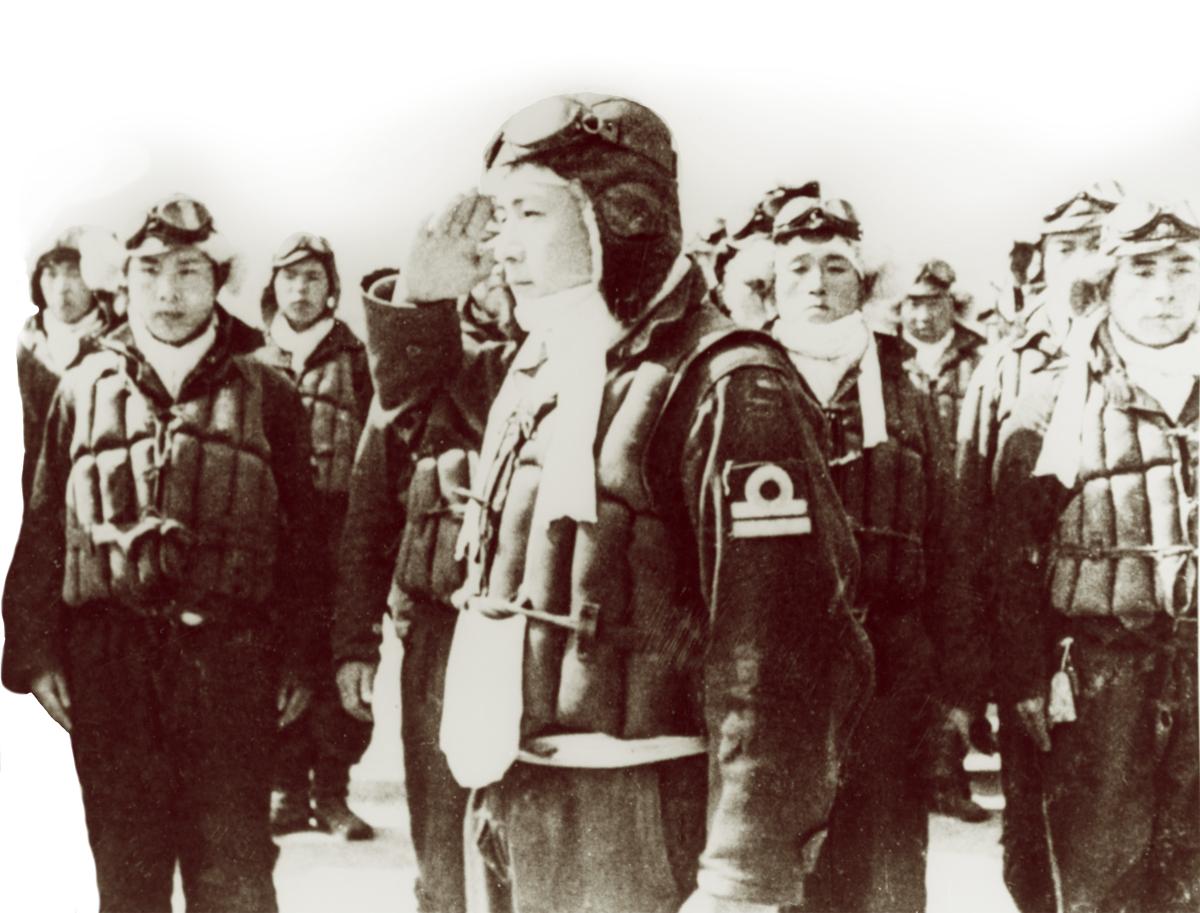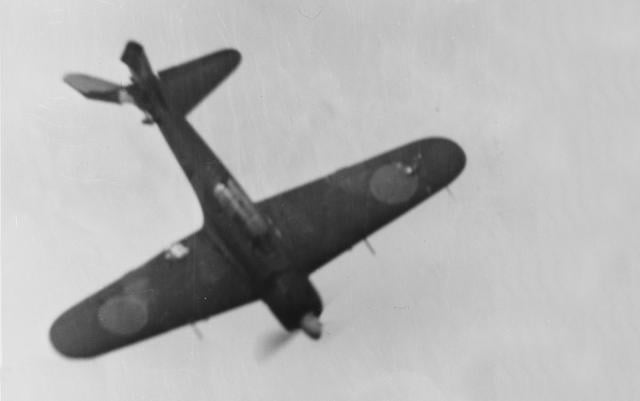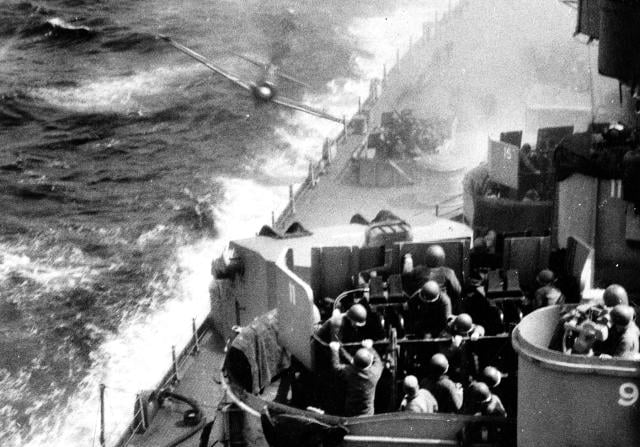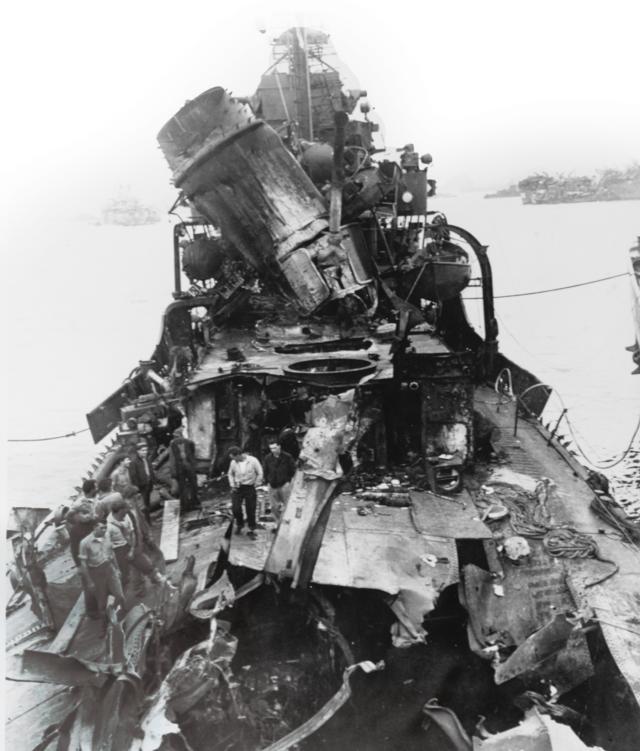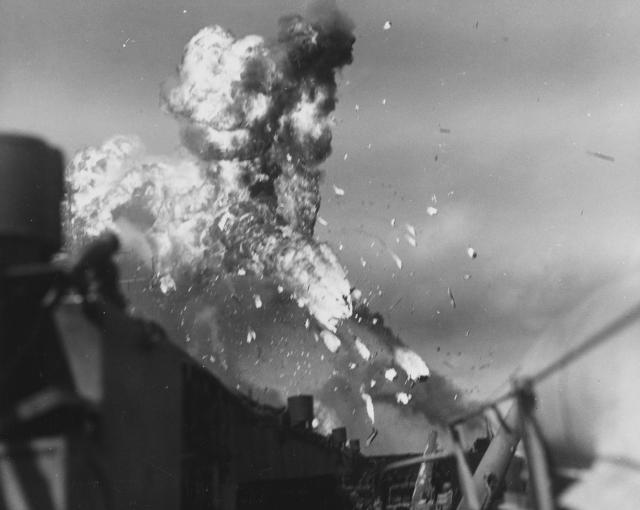On the afternoon of 30 October 1944, Task Group (TG) 38.4 was “about 100 miles to the eastward of Samar” ready to give on-call air support to forces on the Philippine island of Leyte. The Leyte invasion and the Battle of Leyte Gulf had occurred a few days before, and the U.S. Navy controlled the surrounding waters, but not the skies. At 1410, the carrier USS Franklin’s (CV-13) radar detected enemy aircraft 37 miles away and approaching from the west. Twelve fighters were launched, and the Franklin’s crew rushed to put the ship into the highest state of readiness. They did not succeed before three Imperial Japanese Navy (IJN) Mitsubishi A6M Zeros attacked, led by Chief Petty Officer Sei Sakita.1
The first “missed the ship and crashed in the water on the starboard side.” Moments later, the second plane crashed into the carrier. Its 551-pound bomb detonated, blowing “a hole about 30 by 35 feet” in the flight deck. Fires spread swiftly, consuming planes on the hangar deck and spreading into the ship through unsealed hatches. The third plane dropped its bomb harmlessly and then made an aggressive turn toward the light carrier Belleau Wood (CVL-24). Despite being hit “repeatedly by the barrage of antiaircraft fire,” the A6M crashed into the Belleau Wood’s flight deck and set the planes spotted there ablaze. Both carriers would survive, but TG 38.4 lost half its carrier strength in a single attack by just a few determined pilots.2
The Franklin and Belleau Wood were victims of kamikazes. By late 1944, the steady attrition of Japanese planes and pilots in the face of the U.S. Navy’s increasingly sophisticated air defense capabilities led both the IJN and the Imperial Japanese Army (IJA) to search for alternative means of attack. Several officers—including Vice Admiral Takijiro Onishi, newly appointed commander of the First Air Fleet—believed the best answer was to form Tokubetsu Kogekitai, dedicated units that would attack in small groups and make up for their lack of concentrated striking power by deliberately crashing their planes into enemy ships. Anticipating the Allied invasion of the Philippines, Onishi formed the First Kamikaze Special Attack Corps in mid-October 1944.
The U.S. Navy was surprised by these new tactics and rushed to respond to the unanticipated threat, building off of its rich history of innovating with new tactics and technologies.3 Two broad paths were pursued. In the combat theater, task forces introduced new, adaptive tactics based on firsthand combat experience. At the same time, a new experimental unit was formed in the United States to investigate more fundamental challenges and improve the U.S. Navy’s underlying capabilities. The combination of these two allowed the Navy to overcome the determined efforts of Japanese pilots and position itself for the missile age.
Sacrificial Tactics
By 1944, the Navy’s air defense system had evolved to address conventional attacks by large groups of enemy planes. During 1942, the greatest challenge had been effective fighter direction, intercepting an incoming attack with the combat air patrol (CAP) in time to break it up and reduce its strength. Despite the Navy’s best efforts, in each of the four carrier battles that year, enough attacking planes got through to damage at least one carrier. Increasingly sophisticated radars and refined combat information center (CIC) techniques allowed the Navy’s fighter direction procedures to improve so that, by June 1944, the traditional relationship between offense and defense had reversed. At the Battle of the Philippine Sea, Admiral Raymond Spruance loitered close to the Saipan invasion fleet, confident that Task Force (TF) 58’s CAP would intercept the attacks of Vice Admiral Jisaburo Ozawa’s Mobile Fleet. In the resulting “Marianas Turkey Shoot” the Japanese lost 243 planes out of 373 sent against TF 58. None of Spruance’s carriers were hit.4
Japanese pilots began to look for weaknesses in the Navy’s air defense system. One preferred tactic was to attack at night, when fighter interception was far more difficult. Another was to attempt to reduce the effectiveness of radar. IJN torpedo bombers used both. They approached at night and orbited outside the range of radar-directed gunfire, breaking off one at a time to attack independently. Surprisingly, this made shooting them down much more difficult. CIC teams often failed to notice the lone attacker in time to alert the commanding officer and bring the guns on the target. The Japanese quickly realized that a single plane could be much more difficult to detect.5
Kamikaze tactics integrated this knowledge with several other innovative techniques designed to exploit weaknesses in the Navy’s air defense system. Kamikazes approached as a group, but once within range of a TF’s fighter direction system, they broke up. Planes made their way to the target individually or in small groups; this overwhelmed CIC teams because there were too many targets to track. Vice Admiral Lloyd Mustin, who studied the problem, described the challenge: “The confusion factor is as intense as he [the enemy] can make it, and the business of picking out which target you want . . . picking out which [radar] pip is a target, and then which of many targets is the proper one . . . is a bit complicated. . . . It’s an identification process that taxes a well-trained group of people typically found in a ship’s [CIC].”6 Along their way to the target, kamikazes made “radical changes in course and altitude” complicating the process of interception. To further reduce the chances of shooting them down, kamikaze pilots creatively used cloud cover to hide from CAP fighters.7
Kamikazes exploited everything the Japanese had learned about Navy radars and their limitations. By closely following strike aircraft that were returning to their carriers, kamikazes could blend into their radar return and approach undetected. Low-altitude approaches reduced the distance at which search radars could detect kamikazes; often, defending fighters could make just one pass on low flyers before they dove at ships. Other kamikazes loitered in the radar “blind spot” directly overhead until they suddenly attacked. The use of “window” (chaff) allowed kamikazes to “inhibit radar tracking just long enough” to close. Finally, because Navy search radars had difficulty detecting targets over land, kamikazes learned to fly over it before attacking. Clever uses of altitude, terrain, and radar countermeasures all minimized the effectiveness of the Navy’s air defense system.8
Taken together, these tactics allowed kamikaze raids to be an estimated seven to ten times more effective than conventional ones. During the first four months of kamikaze attacks, from October 1944 to January 1945, the Navy’s Operations Research Group (ORG) estimated that 1,444 Japanese planes had attacked. Of them, 352 had been kamikazes, and they scored 121 hits—a success rate of more than 34 percent. Conventional attacks made only 23 hits—just a 2 percent success rate.
These general trends continued in the Okinawa campaign, during which, ORG estimated, 793 kamikazes attacked. Of these, 181 (23 percent) hit ships, and 95 (12 percent) crashed close enough to cause damage. Conventional attacks were far less successful: Of 1,119 attempts, just 16 (1.4 percent) damaged ships. One significant change off Okinawa was that a higher percentage of kamikazes went after smaller vessels; 86 percent of them aimed at nothing larger than a destroyer, compared to just 61 percent in the Philippines. This may have been because of the Okinawa campaign’s extensive use of radar pickets.9
Kamikazes also exploited the limitations of antiaircraft guns. Conventional attacks could be discouraged by the multitude of automatic antiaircraft weapons mounted on board ships late in the war, but kamikazes were more determined; they often crashed into ships after control surfaces had been shot away. To reliably defeat a kamikaze, it had to be knocked down. The Navy’s 20-mm and 40-mm guns lacked the destructive power to bring down a kamikaze. The 5-inch gun quickly became the preferred weapon for fighting off suicide attacks, especially when coupled with the “VT” or proximity fuse. (“VT” or “variable time” was the Navy’s way of obfuscating the significance of the new proximity fuse, which used a small radar to ensure detonation when a plane was nearby.)
The effectiveness of the 5-inch fuse and the proximity fuse against kamikazes stood out in ORG’s analysis. It was undoubtedly the best weapon against suicide attacks. The reduced effectiveness of the 40-mm against kamikazes also was noted; powerful weapons that could destroy enemy planes with a single round were needed.10
Lessons and Adaptations in the Fleet
The Navy was quick to recognize the serious nature of the threat. In December 1944, Admiral William F. Halsey Jr., commander of the Third Fleet, wrote, “The Japanese air command . . . has . . . evolved a sound defensive plan against carrier attacks. He has coordinated and centralized his command responsibilities, but decentralized and dispersed his air forces.” Kamikaze attacks, because they could be made by lone attackers and small groups, allowed more dispersion of planes and pilots. Halsey and other senior officers rapidly introduced tactical adaptations designed to minimize the effectiveness of kamikazes.11
Once within range of shipboard weapons, kamikaze attacks developed very quickly. The standard mechanism for controlling 5-inch guns was the Mk 37 Fire Control System, but it was often slow to lock on fast-moving targets. Flexible wiring allowed shipboard fire control systems to be reconfigured. Smaller, more nimble directors designed for automatic weapons could develop slightly less accurate fire control solutions much more rapidly. When connected to 5-inch guns, they could get the larger weapons onto kamikazes very quickly. This knowledge spread rapidly through the fleet, but later tests suggested it was an ineffective approach. Vice Admiral Mustin blamed it for the kamikaze hit on the battleship Missouri (BB-63), the only fast battleship that was struck.12
Radar picket destroyers could help track and intercept incoming attackers long before they threatened the main fleet. Radar pickets had been part of the Navy’s tactical doctrine for years, but they began to be used much more frequently after kamikaze attacks began. Off Okinawa, 16 radar picket stations were arranged at distances from 18 to 95 miles. Originally occupied by a single destroyer and a few landing ships, the most vulnerable stations soon received a second destroyer or destroyer escort. Japanese pilots approaching the invasion fleet from Kyushu or Formosa often sighted the pickets and attacked immediately. Because destroyer CICs could track and intercept a maximum of two incoming threats at a time, it only took a handful of kamikazes to overwhelm a radar picket. Ten destroyers and destroyer escorts were sunk and 32 damaged while on this picket duty.13
Learning from this experience, the commanders of the fast carrier task forces took a different approach. They also used destroyer pickets, but rather than dispersing them alone or in pairs, they arranged destroyers in a “radar picket line, composed of two or three destroyer divisions.” The line had at least four ships and “usually six or eight,” ensuring that the picket line had the firepower to fight off kamikaze attacks; during TF 58’s support of Okinawa, only two picket line destroyers were damaged; none were sunk. TF 58 was able to concentrate its destroyers and arrange them along the “most probable” line of enemy approach because of its mobility; unlike the invasion forces off Okinawa, TF 58 did not remain in a fixed location.14
Two to four divisions of CAP fighters were assigned to TF 58’s picket line, allowing the fast carriers to mitigate two specific kamikaze tactics. The pickets could vector their fighters to intercept incoming raids farther out, beyond the 50 to 60 miles where kamikaze formations tended to break up. This helped ensure Japanese formations were attacked before they dispersed and overwhelmed the capacity of CIC teams. To prevent kamikazes from following returning strikes, the destroyers of the picket line used their CAP fighters to “filter” incoming formations, visually investigating them and shooting down any Japanese shadowers. During the Okinawa campaign, the picket line used these techniques to destroy an estimated 86 enemy planes; the destroyers shot down 27 more with their guns.15
By this time, carriers had started carrying more fighters, to provide a larger CAP and to regularly sweep enemy airfields, destroying kamikazes at their source. The shift began in the fall of 1944, after the initial suicide attacks. While preparing for the assault on Luzon, air groups that had an average of 38 fighters were reconfigured to have 73; to make space, the numbers of dive bombers and torpedo bombers were reduced, from 36 to 15 and 18 to 15, respectively. To make up for the loss in attack strength, half the fighters were fighter bombers capable of carrying bombs and rockets.16
Vice Admiral John S. McCain, who commanded the fast carriers during the Luzon operation, used these additional fighters to place a “Big Blue Blanket” over Japanese airfields on the island, making fighter sweeps day and night to prevent enemy planes from taking off or landing for three straight days in December 1944. Destroying kamikazes at their source proved very effective; by late December, two carriers—the Essex (CV-9) and Wasp (CV-18)—were carrying even more fighters (91). The fast carriers tried to repeat their success off Kyushu during the Okinawa campaign but were less successful. There were too many Japanese planes and airfields to replicate the “blanket.”17
McCain introduced other tactics. The fast carrier TF was reorganized, with three rather than four carrier groups. The concentration of carriers made it more difficult for kamikazes to penetrate the CAP, and the additional vessels in each screen increased the amount of antiaircraft fire.18 McCain also established “Jack Patrols,” small groups of fighters stationed at altitudes below 3,000 feet around the task force at each of the four cardinal points, north, south, east, and west. Flying within visual distance of the screen, the Jack Patrols increased the odds of intercepting low-altitude attacks. McCain’s goal was to ensure “100 percent destruction of the attackers.” It appeared to work; no fast carriers were hit in December.19
However, 1945 saw an increasing number of kamikaze attacks. The large carriers Ticonderoga (CV-14), Randolph (CV-15), Hancock (CV-19), Bunker Hill (CV-17), Intrepid (CV-11), and Enterprise (CV-6) were struck by kamikazes, the Intrepid and Enterprise on two separate occasions. The Saratoga (CV-3), Enterprise, Yorktown (CV-10), Franklin, Wasp, and Essex were bombed by attackers that employed similar tactics to conceal their approach.20 After Okinawa, TF 58’s action report noted:
Fighter direction met its most strenuous test in the . . . Kyushu-Okinawa operations. Rarely have the enemy attacks been so cleverly executed and made with such reckless determination. These attacks were generally by single or few aircraft making their approach with radical changes in course and altitude, dispersing when intercepted and using cloud cover to every advantage. They tailed our friendlies home, used decoy planes, and came in at any altitude or over the water. . . . Never before . . . have the limitations of our present equipment become so pronounced, and the enemy, fully aware of these limitations gained by experience and other means, made every effort to attack this force . . . with quite effective results.21
Adaptations within the fleet could only do so much. More significant changes were needed to address the flaws the Japanese were exploiting.
Improvements and Experimentation
On 1 July 1945, the Navy formed TF 69, a special experimental unit under Vice Admiral Willis A. Lee Jr. It was a “fast-reaction outfit” tasked with finding an effective kamikaze defense. The use of a dedicated organization, outside of the operational fleet, to test new tactics and technologies was innovative. TF 69—which became the Operational Development Force (OpDevFor)—worked with the Navy’s technical bureaus and explored multiple avenues in an effort to mitigate the kamikaze threat.22
One of the most promising was a new 3-inch gun, the smallest weapon that could fire proximity-fuse projectiles and knock kamikazes out of the sky. Semiautomatic 3-inch mountings were expected to replace existing 40-mm mounts, with one 3-inch for each pair of 40-mm. Because preliminary studies suggested that the new 3-inch would be nearly equal to the 5-inch in effectiveness, swapping 40-mm guns for 3-inch ones would improve anti-kamikaze firepower by two to five times, even with the reduced number of barrels. In late June 1945, the Navy’s Bureau of Ordnance requested “overriding priority” for the 3-inch project.23
Improved radar coverage was desperately needed, and there was already a program under way to augment shipboard radars with airborne ones. Project Cadillac (named after the tallest mountain on the U.S. Eastern Seaboard) had been conceived in 1942; its original intent was to allow surface search beyond the horizon. In early 1944, the requirement was changed to detect low-flying aircraft approaching below the beams of shipboard radars. Cadillac mounted the APS-20 aerial radar in a converted Grumman TBF and linked the radar’s display to the host ship’s CIC via radio link. The APS-20 effectively operated as one of the ship’s own radars. Tests were conducted starting in February 1945; they revealed problems with the radio link but suggested promise. Shipboard trials began in May and proved that Cadillac would increase the fleet’s ability to detect and intercept low-flying kamikazes. When the war ended, plans were under way to equip four fleet carriers with the necessary planes and equipment.24
The Cadillac concept merged with the success of the destroyer pickets to trigger a desire for an airborne CIC that could direct fighters. It became Cadillac II. Although it also used the APS-20, the concept was fundamentally different. Instead of augmenting shipboard capabilities, the radar was used by CIC operators within the host aircraft, a converted Boeing B-17. The goal was to augment a TF’s fighter direction capabilities and provide a new mechanism for vectoring CAP fighters to intercepts. Patrol Bombing Squadron 101 was formed on 2 July 1945 and, had the war gone ahead, likely would have provided fighter direction for Navy TFs during the assault on Kyushu.25
Another successful experiment involved using U.S. Army radars to improve early warning over land. The Army’s SCR-270 was a lightweight set that could be placed on a landing ship and used as it approached the beach. Once the ship had landed, the radar could be disassembled in six to 12 hours and reassembled ashore in a similar amount of time. It would provide additional radar coverage for landing forces, and, because the SCR-270 was more effective at discerning aircraft approaching over land and less susceptible to “window,” it could augment a landing force’s fighter direction capabilities. TF 69 proved the feasibility of this concept in July 1945.26
Other efforts were less successful. A variety of approaches were tried to address the radar “blind spot” directly overhead. TF 69 modified existing radars with new antennas, mounted radars on tilting pedestals, and tried other configurations. None worked. The best approach to addressing the problem appeared to be airborne radars.27
No immediate solution was found for the most important limiting factor—the operators at the heart of the fighter direction process. They needed faster updates to the evolving picture around them and more accurate information to make better decisions. The display of information in existing CICs was “slow, complicated, and incomplete, rendering it difficult for the human mind to grasp the entire situation rapidly or correctly.” As a result, no more than a few raids could be handled simultaneously by a single CIC. The distributed nature of kamikaze attacks had found the effective limit of the Navy’s system, the operators at the heart of it. Although the fleet was addressing the problem by networking the CICs of a task force and distributing the load, the ultimate answer was an automated CIC that could computerize much of the necessary information processing. The Navy began to move this direction after the war, and ultimately standardized it as the Naval Tactical Data System in the 1960s.28
Adaptation and Mitigation
Although kamikaze attacks were unanticipated and extremely deadly, the U.S. Navy was able to overcome the threat. Adaptations in the combat theater began to mitigate specific Japanese tactics and improve the survivability of the fleet. At the same time, an extensive investment in experimentation sought to explore new approaches and evolve the Navy’s air defense capabilities.
In many respects, kamikazes foreshadowed the age of guided missiles, presenting the Navy’s ships with multiple radically maneuvering threats that deliberately tried to overwhelm existing air defense systems. Lessons from the experience of kamikaze attacks in World War II prepared the Navy for the next phase of fleet air defense, with aerial radars, automated CICs, and networked capabilities that harnessed distributed sensors into a comprehensive system. The Navy was able to do this—to learn so rapidly in the face of a new and unanticipated threat—because of the investments it had made in developing a learning system in the decades before the war. That learning system paid dividends in the last year of the war as the Japanese shifted to increasingly deadly forms of attack.
1. Mike Yeo, Desperate Sunset: Japan’s Kamikazes against Allied Ships, 1944–45 (Oxford: Osprey Publishing, 2019), 87–90.
2. “War Damage to U.S.S. Franklin (CV13) during action with enemy aircraft 30 October 1944,” Commanding Officer, USS Franklin, 20 November 1944; Yeo, Desperate Sunset, 87–90.
3. Trent Hone, Learning War: The Evolution of Fighting Doctrine in the U.S. Navy, 1898–1945 (Annapolis, MD: Naval Institute Press, 2018).
4. Captain Wayne P. Hughes, USN (Ret.), Fleet Tactics and Coastal Combat, Second Edition (Annapolis, MD: Naval Institute Press, 2000), 105–08; Norman Friedman, Fighters Over the Fleet: Naval Air Defense from Biplanes to the Cold War (Annapolis, MD: Naval Institute Press, 2016), 125.
5. “Outline of CIC Lectures for Destroyer PCOs and PXOs, COTCLANT,” 1 May 1944.
6. Vice Admiral Lloyd M. Mustin, The Reminiscences of Vice Admiral Lloyd M. Mustin, interviewed by John T. Mason Jr. (Annapolis, MD: U.S. Naval Institute, 2003), 904.
7. “Report of Operations of Task Force Fifty-Eight in Support of Landings at Okinawa, 14 March through 28 May,” Commander Task Force Fifty-Eight, 18 June 1945; Norman Friedman, U.S. Naval Weapons (Annapolis, MD: Naval Institute Press, 1982), 93; Friedman, Fighters, 153–54.
8. “Report of Operations of Task Force Fifty-Eight;” Friedman, Naval Weapons, 93; Friedman, Fighters, 153–54.
9. “Anti-Aircraft Study No. 3, Memorandum on Suicide Attacks,” Office of Scientific Research and Development, 3 February 1945; “Antiaircraft Action Summary, Suicide Attacks, April 1945,” COMINCH P-009, 30 April 1945; Antiaircraft Action Summary, World War II, 8 October 1945, Headquarters of the Commander in Chief, United States Fleet; “Anti-Aircraft Study No. 13, Anti-Aircraft Actions in the Okinawa Campaign, 18 March–15 August 1945,” Office of Scientific Research and Development, 12 October 1945.
10. “Anti-Aircraft Study No. 8, AA Defense of the Fast Carrier Task Force 24 October 1944 to 21 March 1945,” Office of Scientific Research and Development, 11 September 1945.
11. Quoted in Samuel Eliot Morison, History of United States Naval Operations in World War II, vol. 13, The Liberation of the Philippines: Luzon, Mindanao, the Visayas, 1944–1945 (Boston: Little, Brown and Company, 1959), 53.
12. The smaller directors were the Mks. 51, 52, and 57. Norman Friedman, Naval Antiaircraft Guns and Gunnery (Yorkshire, UK: Seaforth Publishing, 2013), 274; Friedman, Naval Weapons, 86; Mustin, Reminiscences, 880–84.
13. Radar Doctrine, U.S. Pacific Fleet, 31 December 1941; Battle Experience Radar Pickets and Methods of Combating Suicide Attacks off Okinawa, March–May 1945, 20 July 1945, Headquarters of the Commander in Chief, United States Fleet; Yeo, Desperate Sunset, 194; Friedman, Antiaircraft Guns, 272; Samuel Eliot Morison, History of United States Naval Operations in World War II, vol. 14, Victory in the Pacific, 1945 (Boston: Little, Brown and Company, 1960), 189.
14. “Report of Task Force Fifty-Eight.”
15. “Report of Task Force Fifty-Eight.”
16. Morison, The Liberation of the Philippines, 52–55.
17. “Report of Operations of Task Force Fifty-Eight”; Morison, The Liberation of the Philippines, 55–57, 87.
18. Morison, The Liberation of the Philippines, 52–55.
19. Morison, The Liberation of the Philippines, 58; “Operational Experience of Fast Carrier Task Forces in World War II,” Weapons System Evaluation Group (WSEG) Staff Study No. 4, 15 August 1951.
20. “Operational Experience of Fast Carrier Task Forces.”
21. “Report of Operations of Task Force Fifty-Eight.”
22. Mustin, Reminiscences, 908.
23. Friedman, Antiaircraft Guns, 273; Friedman, Naval Weapons, 73.
24. Friedman, Fighters, 157–62.
25. Friedman, Fighters, 162.
26. Friedman, Fighters, 157.
27. Friedman, Fighters, 157.
28. Friedman, Fighters, 324–26; Friedman, Naval Weapons, 143–45.



